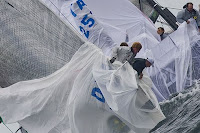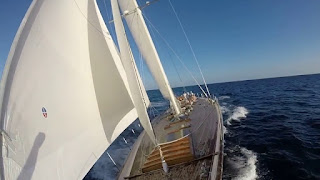Bowmen, life at the pointy end

Q: what do you call someone who hangs out with sailors?
A: A bowman
But in reality the bow position is a fulcrum of a large team effort and is very reliant on that crew behind him. It is impossible for him to do a good job without every other member of the crew helping him; trimmers, mast, pit, steerers and even tacticians all have a role in assisting the bow. Life can be a nightmare for the bow when things go wrong behind him. As the bow is a very visual position and the focus of a lot of attention in manoeuvres, it is quite often they who get the blame when things go awry. It always amazes me that when a spinnaker drop goes wrong the bow is yelled at when quite probably the fault lies further aft and he is trying simply to cope with a bad situation.
So what does it take to become a good bowman, it is a very physical spot so you will have to be fit and agile. Arm and leg strength along with balance are very important attributes. Rock climbing and circuit training are popular training regimes amongst top level bowmen. It is a requirement to work in a very confined space with a lot going on around you, sheets and sail everywhere. In this environment with so much having to happen in a short time it is imperative to have a strong sense of priority and awareness, there is nothing worse than seeing something from the back of the boat that desperately needs attending to and the bow is attending to some irrelevant job that can wait. The bow literally runs the front of the boat, he will receive his instructions from the sailing master or tactician and he has to co-ordinate the sail process, from getting a sail up on deck to making sure the halyard and sheets are right to go. It is important to be aware that working right in the very bow of the boat is performance retarding and so you must be structured and methodical in your approach to minimise time forward. Never rush, think things through, the speed of preparation come with competence not haste. The mere act of walking around a boat is important, in light airs place one foot down before lifting the other, never jump or bounce, it is amazing how heavy feet can reverberate through the boat. In rough weather the old adage “one hand for you and one for the boat” rings true. Going overboard is no one’s idea of fun.
As we all know conditions change all the way through a race and there is always the possibility of a last minute change of plans at mark rounding’s. Don’t grizzle or get angry, the reason the change has been called is because circumstances have changed and the boat will benefit by the amendment even at the expense of having to re setup again. So keep your options open and be ready to change, think ahead to the next likely manoeuvre and make sure all is ready and what new situation may confront you. A lot should be done prior to leaving the dock, check the halyards and spinnaker pole, make sure the sails are packed ready to go, check your feeder and forestay on boats with foils, check with the tactician on the likelihood of which sails are to be used and stack them below accordingly.
On larger boats the bowman plays a major role at the start, he is the forward eyes of the boat in the prestart hustle and bustle. Working and weaving your way through a large fleet can be quite harrowing so work on developing a nice clear set of hand signals with the steerer so he can communicate with him above the noise. As part of your pre-race setup once the start line is in place, have the boat sail along the starting line and set up some transits on the shore that will give you an indication of how close to the line your boat is when you come in for a start. Hold up fingers to signify how far off the line you are, two fingers for two boat lengths etc. A clenched fist will show the boat is on the line. Remember the steerer has a blind spot behind the jib so keep an eye on boats in that region to leeward and signal if they are luffing or converging. It is also a good idea for have the countdown going as well in the bow, it can be very hard for the helm to judge exactly where his bow is with all the boats around and when it becomes obvious to the bow that the boat will arrive on the line late, a quick winding motion can let the steerer and trimmers know to press on and go for it.
Remember the pyramid of yachting success, a base of good boat handling will bring good boat speed and good boat speed will bring good tactics; remember a good bow person is vital to good boat handling (just don’t tell them that!).
Tony Bull
Ullman Sails
www.ullmansails.com



Comments
Post a Comment